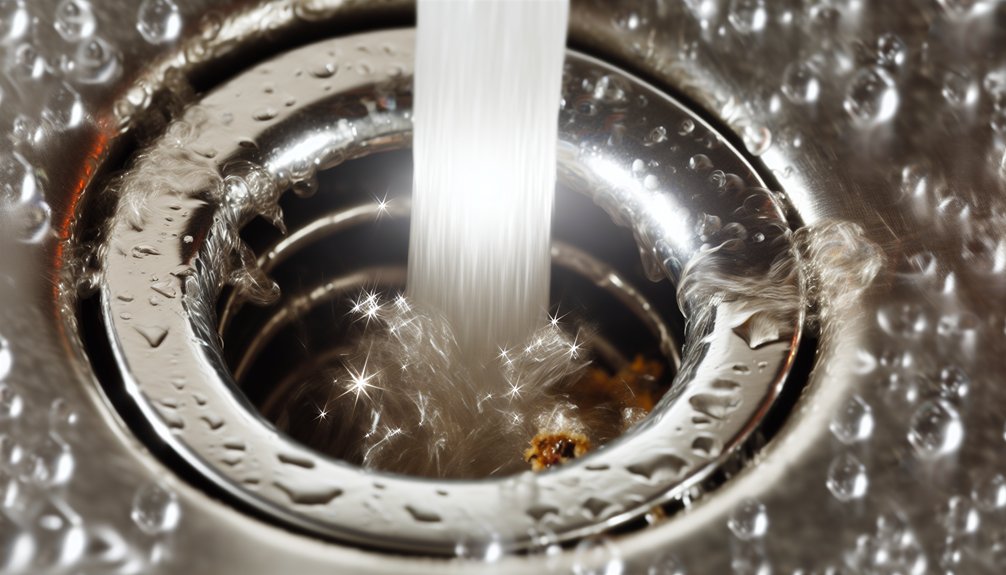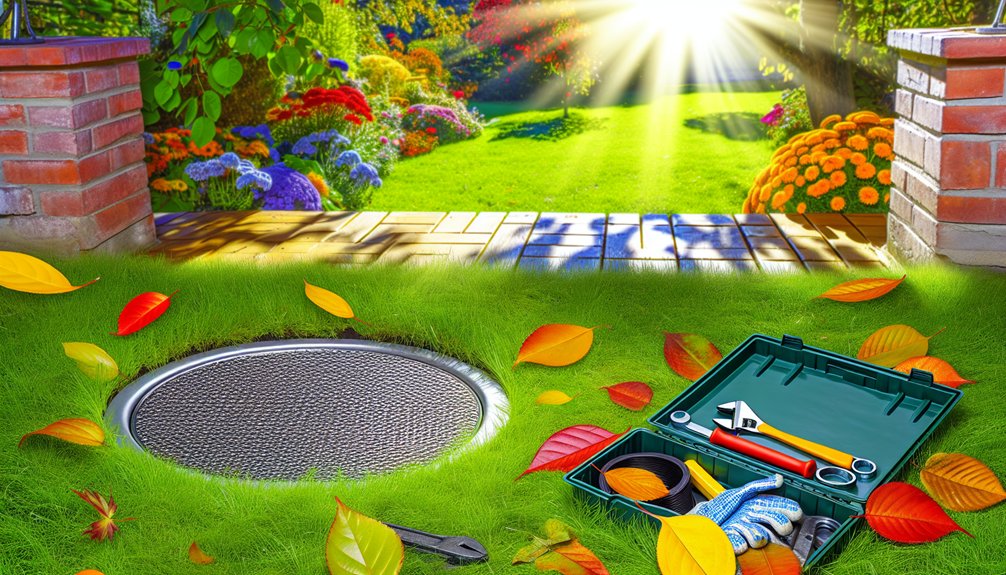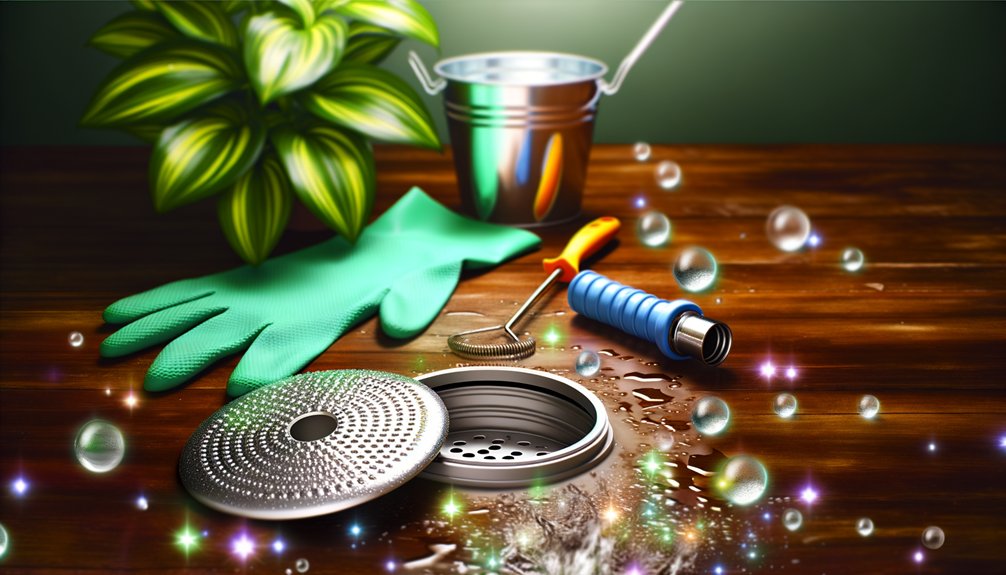Effective drain maintenance requires systematic actions. First, regularly remove visible debris to prevent clogs. Utilize baking soda and vinegar for routine cleaning. It's also important to flush drains with hot water weekly. Avoid certain foods that can cause obstructions, and install drain screens for added protection. Additionally, schedule yearly professional cleanings for thorough assessments. Finally, use protective gear during maintenance to guarantee safety. For a detailed approach, further insights await exploration.
Regularly Remove Visible Debris

Regularly inspecting and removing visible debris from bathroom drains is essential for preventing clogs. Accumulations of hair, soap residue, and foreign objects can obstruct ideal water flow, leading to clogged drains that strain the plumbing system. By employing tools such as tweezers or pliers, individuals can carefully extract debris without pushing it further into the system, thereby minimizing potential damage. Establishing a routine for this process, ideally on a weekly basis for heavily used drains, promotes hygiene and prevents future maintenance issues. In addition, implementing drain screens or stoppers can effectively capture hair and debris, making regular removal more efficient. This proactive approach not only saves time and money on plumbing repairs but also contributes to a more liberated living space, free from the constraints of plumbing emergencies. Regularly removing visible debris is crucial for sustaining the long-term functionality of bathroom drains.
Utilize Baking Soda and Vinegar Solutions
The baking soda and vinegar solution employs a chemical reaction that effectively disintegrates organic matter and debris within drains. This method not only addresses existing clogs but also serves as a preventive measure when incorporated into a regular maintenance routine. By utilizing this natural solution, homeowners can maintain clear drains and eliminate unpleasant odors efficiently.
Chemical Reaction Benefits
Utilizing a baking soda and vinegar solution demonstrates a highly effective method for drain maintenance through a chemical reaction. This combination produces carbon dioxide gas, which helps dislodge and break down organic matter responsible for stubborn clogs, such as grease, soap scum, and hair. Introducing a cup of baking soda followed by a cup of vinegar initiates a fizzing action that effectively loosens these blockages. Allowing the mixture to sit for 15-20 minutes enhances its effectiveness, as the acids work on the debris. To complete the process, flush your drains with hot water, washing away the loosened materials and promoting clearer drainage. This natural approach is not only effective but also environmentally friendly, offering a safe alternative to harsh chemical drain cleaners.
Regular Maintenance Routine
Establishing a weekly maintenance routine that incorporates a baking soda and vinegar solution can greatly enhance drain functionality and longevity. This method involves pouring ½ cup of baking soda followed by ½ cup of vinegar down the drain, allowing the mixture to sit for 15-20 minutes to maximize its effect on breaking down organic matter. Finally, flushing with hot water clears away loosened debris, promoting a healthier plumbing system.
| Step | Action |
|---|---|
| 1. Pour Baking Soda | Add ½ cup down the drain |
| 2. Add Vinegar | Follow with ½ cup |
| 3. Wait | Let sit for 15-20 minutes |
| 4. Flush | Rinse with hot water |
| 5. Repeat Weekly | Maintain for ongoing drain health |
Regular use of this natural solution can prevent clogged drains while minimizing costly plumbing repairs.
Flush Drains With Hot Water

Flushing drains with hot water serves as an effective method for maintaining clear plumbing and preventing clogs. Regularly pouring hot water down drains aids in breaking down and dissolving built-up materials, ensuring pipes remain unclogged. This practice is particularly beneficial for melting away fatbergs and grease, common culprits of blockages. It is advisable to flush drains at least once a week to promote ideal flow and deter stagnant debris, which can lead to unpleasant odors and bacterial growth. Consistent flushing also helps prevent the gradual reduction of drain diameter caused by continuous accumulation, which may result in slow draining. While utilizing boiling water, caution should be exercised with PVC pipes to avoid damage. By implementing this simple yet effective technique, homeowners can greatly reduce the need for costly plumbing services and minimize reliance on drain cleaning services, ultimately maintaining clear pipes for a more efficient drainage system.
Avoid Disposing of Certain Foods
While it may seem convenient to dispose of certain food items down the drain, this practice can lead to considerable plumbing issues. It is essential to avoid disposing of certain foods, such as coffee grounds, peanut butter, and grease, as they can accumulate and create tough clogs within drain pipes. Starchy foods like rice and pasta expand when wet, forming obstructions that hinder water flow. Additionally, raw meat and fish bones can snag in plumbing, exacerbating blockages. Non-food items, including baby wipes and feminine hygiene products, should never enter the garbage disposal or sink, as they do not break down in water and can cause severe clogs, leading to unpleasant odors. Implementing preventive measures by carefully managing kitchen waste is vital for maintaining drain efficiency and preventing costly plumbing repairs. Responsible disposal practices contribute greatly to overall drain maintenance success.
Install Drain Screens and Catchers

Implementing drain screens and catchers in sinks and showers is a highly effective method for trapping hair, soap residue, and other debris, thereby greatly reducing the risk of clogs. Homeowners can easily install drain screens, which are available in various materials and price ranges, typically costing between $5 and $13, making them an affordable solution. Regularly cleaning these screens is essential; weekly maintenance guarantees their effectiveness in preventing build-up and minimizing unpleasant odors caused by decomposing organic matter in pipes. By utilizing drain catchers, not only is the occurrence of clogs markedly mitigated, but the overall plumbing system benefits as well. Proper installation and diligent upkeep of drain screens can extend plumbing lifespan by reducing the frequency and severity of clogs, ultimately leading to a more efficient drainage system and enhanced home comfort. Additionally, maintaining your gutters can significantly aid in preventing flooding by ensuring proper water diversion away from your home's foundation.
Schedule Yearly Professional Cleaning
Scheduling yearly professional cleaning of drains offers numerous benefits, including the early identification of potential plumbing issues. This maintenance frequency is essential for utilizing advanced inspection techniques, such as video assessments, to evaluate pipe conditions accurately. Additionally, employing specialized tools like a plumber's snake can effectively remove stubborn debris, ensuring peak drain functionality throughout the year.
Benefits of Professional Cleaning
Yearly professional drain cleaning services offer numerous benefits that enhance the functionality and longevity of plumbing systems. By scheduling these services, homeowners considerably reduce the risk of stubborn clogs, which can lead to costly plumbing repairs. Professional cleaning often includes video inspections, allowing for a detailed assessment of pipe health and the identification of potential issues before they escalate. Skilled plumbers utilize specialized tools, such as a plumber's snake, to effectively address built-up debris that DIY methods may overlook. Additionally, regular professional maintenance promotes plumbing efficiency and hygiene, contributing to a healthier home environment by minimizing the chances of foul odors and water contamination. Ultimately, investing in professional cleaning services is a strategic move for sustainable plumbing care.
Frequency Recommendations for Maintenance
Professional drain cleaning services play an essential role in maintaining plumbing systems, and their frequency can greatly impact overall efficiency. It is recommended to schedule professional drain cleaning at least once a year to guarantee thorough maintenance and prevent potential clogs. This yearly service often includes video assessments of pipe health, enabling professionals to identify issues before they escalate. Regular professional cleaning considerably reduces the likelihood of severe clogs that can lead to costly repairs. Plumbing experts advocate combining this annual service with routine DIY drain maintenance every few months. Investing in professional drain cleaners not only removes built-up debris but also extends the lifespan of pipes and drains, ultimately promoting ideal drain health and functionality.
Inspection Techniques and Tools
Effective inspection techniques and tools are critical to ensuring the long-term health of plumbing systems. Scheduling yearly professional drain cleaning services not only enhances hygiene but also facilitates thorough inspections. The following tools are commonly employed:
- Video Inspection Cameras: Allow for accurate assessment of pipe conditions, identifying blockages and damage not visible through traditional methods.
- Plumber's Snake: This tool is essential for breaking up stubborn clogs and removing built-up debris effectively.
- Drain Covers: Proper installation and maintenance can prevent debris accumulation, enhancing overall system efficiency.
Utilizing professional help from a reputable plumbing company can greatly extend the lifespan of plumbing systems, minimizing costly repairs and unexpected clogs through proactive drain cleaning and maintenance.
Use Protective Gear During Maintenance
Ensuring safety during drain maintenance requires the proper use of protective gear. It is essential to don rubber gloves to protect the hands from sharp debris and harmful chemicals found in drains. Safety goggles must be worn to shield the eyes from splashes and potential irritants, particularly when utilizing chemical drain cleaners or handling hot water. A face mask is advisable to prevent the inhalation of harmful fumes during the use of such chemicals or when dealing with moldy, dirty drains.
Long-sleeved clothing and closed-toe shoes should also be part of the protective attire, safeguarding the skin and feet from injury caused by falling objects or harsh cleaning agents. Additionally, maintaining a well-ventilated workspace minimizes exposure to toxic fumes, ensuring a safer cleaning environment. Adhering to these protective measures is crucial for successful and safe drain maintenance.
Frequently Asked Questions
How Do You Maintain a Drain?
To maintain a drain effectively, one should employ various drain cleaning techniques and preventive maintenance tips. Regularly inspecting for signs of blockage, such as slow drainage or unusual odors, can help address common drain issues early. Utilizing eco-friendly solutions, like a baking soda and vinegar treatment, promotes seasonal drain care and reduces chemical use. Additionally, installing screens and scheduling professional cleaning annually enhances overall drain health and longevity, ensuring peak performance.
What Is the First Step in the Drain Cleaning Process?
In a world where knights wielded swords against dragons, the first step in the drain cleaning process involves meticulous drain inspection techniques. By identifying common drain issues, one can utilize effective cleaning tools like tweezers or pliers to extract visible debris. This preventive measure not only addresses immediate clogs but also establishes a foundation for DIY drain solutions. Adhering to a regular drain maintenance frequency enhances long-term functionality and reduces the likelihood of future blockages.
How Do Professionals Clear Drains?
Professionals clear drains using various drain cleaning techniques and advanced professional equipment. Initially, they employ drain inspection methods like video imaging to identify common blockages. Depending on the severity, plumbing tools such as plumbing snakes or high-pressure water jetting may be utilized to dislodge clogs. Enzyme-based cleaners offer a gentler approach for organic matter, while mechanical augers tackle severe blockages. Regular preventive measures, including thorough cleaning and inspections, guarantee peak drain functionality.
Do Baking Soda and Vinegar Really Work on Drains?
Like a gentle tide washing away debris, baking soda and vinegar serve as effective natural solutions for drain cleaning. These DIY methods produce a chemical reaction that aids in clog prevention, breaking down organic matter without the harsh effects of chemical alternatives. Regular use of this combination can enhance maintenance tips by reducing buildup in pipes. However, while useful for minor issues, it may not suffice for severe blockages, necessitating professional intervention.



